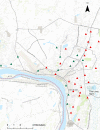Using Land Runoff to Survey the Distribution and Genetic Diversity of Burkholderia pseudomallei in Vientiane, Laos
- PMID: 33257313
- PMCID: PMC7851688
- DOI: 10.1128/AEM.02112-20
Using Land Runoff to Survey the Distribution and Genetic Diversity of Burkholderia pseudomallei in Vientiane, Laos
Abstract
Melioidosis is a disease of significant public health importance that is being increasingly recognized globally. The majority of cases arise through direct percutaneous exposure to its etiological agent, Burkholderia pseudomallei In the Lao People's Democratic Republic (Laos), the presence and environmental distribution of B. pseudomallei are not well characterized, though recent epidemiological surveys of the bacterium have indicated that B. pseudomallei is widespread throughout the environment in the center and south of the country and that rivers can act as carriers and potential sentinels for the bacterium. The spatial and genetic distribution of B. pseudomallei within Vientiane Capital, from where the majority of cases diagnosed to date have originated, remains an important knowledge gap. We sampled surface runoff from drain catchment areas throughout urban Vientiane to determine the presence and local population structure of the bacterium. B. pseudomallei was detected in drainage areas throughout the capital, indicating it is widespread in the environment and that exposure rates in urban Vientiane are likely more frequent than previously thought. Whole-genome comparative analysis demonstrated that Lao B. pseudomallei isolates are highly genetically diverse, suggesting the bacterium is well-established and not a recent introduction. Despite the wide genome diversity, one environmental survey isolate was highly genetically related to a Lao melioidosis patient isolate collected 13 years prior to the study. Knowledge gained from this study will augment understanding of B. pseudomallei phylogeography in Asia and enhance public health awareness and future implementation of infection control measures within Laos.IMPORTANCE The environmental bacterium B. pseudomallei is the etiological agent of melioidosis, a tropical disease with one model estimating a global annual incidence of 165,000 cases and 89,000 deaths. In the Lao People's Democratic Republic (Laos), the environmental distribution and population structure of B. pseudomallei remain relatively undefined, particularly in Vientiane Capital from where most diagnosed cases have originated. We used surface runoff as a proxy for B. pseudomallei dispersal in the environment and performed whole-genome sequencing (WGS) to examine the local population structure. Our data confirmed that B. pseudomallei is widespread throughout Vientiane and that surface runoff might be useful for future environmental monitoring of the bacterium. B. pseudomallei isolates were also highly genetically diverse, suggesting the bacterium is well-established and endemic in Laos. These findings can be used to improve awareness of B. pseudomallei in the Lao environment and demonstrates the epidemiological and phylogeographical insights that can be gained from WGS.
Copyright © 2020 Rachlin et al.
Figures





References
Grants and funding
LinkOut - more resources
Full Text Sources
Other Literature Sources
Miscellaneous

